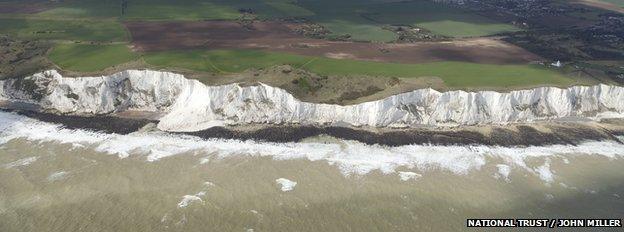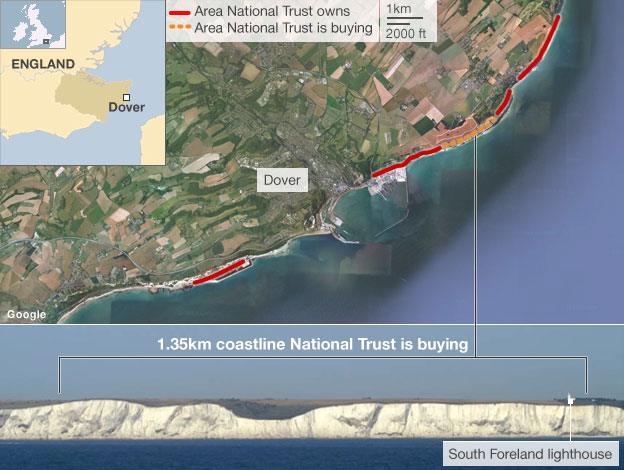Trust bids to secure white cliffs of Dover
- Published
- comments

The white cliffs became a nationally known landmark during World War II
The National Trust is launching a £1.2m appeal to purchase and safeguard part of the white cliffs of Dover.
The trust says purchasing the mile-long stretch to the east of Dover will allow it to prevent building, ensure a public right of way and conserve nature.
The cliffs mark the UK's closest point to France; troops defended here against the Romans' arrival, and many Dunkirk evacuees landed on the local beaches.
The Trust's Dame Fiona Reynolds explains the "triple benefits of access, nature, and landscape"
The chalkland supports wildlife including insects, birds and plants.
The Adonis blue butterfly has a particular liking for chalk.
"Immortalised in song and literature, the white cliffs of Dover have become one of the great symbols of our nation," said Fiona Reynolds, the trust's director-general.
"We now have a once in a lifetime opportunity to secure their future for everyone to enjoy."
The surface of the cliffs, which can be seen from France on a clear day, is kept white by constant erosion.
They were voted the UK's third best "natural wonder" in a 2005 Radio Times poll, behind the Dan yr Ogof caves and Cheddar Gorge, but ahead of such landmarks as the Giant's Causeway and Loch Lomond.

Purchasing this stretch of coast would fill in the gap between two segments already owned by the National Trust, creating a five-mile (8km) contiguous reserve with guaranteed rambling rights and nature protection.
Birds such as kittiwakes and fulmars nest on the cliff face, while peregrine falcons wheel above.
The trust uses Exmoor ponies to graze the chalky topside, enabling plants such as oxtongue broomrape to thrive.
Managers are keen to extend these measures to the new stretch, which currently belongs to a local landowner.
"We own pockets of land either side; but it's a gap in the middle, and from a wildlife point of view you have a gap where you go into farmland and there's not much we can do for wildlife or for people," said Brian Whittaker, acting property manager for the white cliffs.
"The ponies are the best lawnmowers you can get - it's a natural way to look after the grassland, and creates a great deal of attraction for visitors," he told BBC News.
The cliffs are receding at an average rate of 1cm (0.4in) per year, but occasionally large chunks crash into the sea.
The white cliffs of Dover gained nationwide fame through Dame Vera Lynn's eponymous wartime ballad, while Matthew Arnold's 1867 poem Dover Beach focussed on the pounding of the seas rather than the impacts of war.
- Published13 June 2012
- Published14 March 2012
- Published23 June 2011
- Published7 June 2011